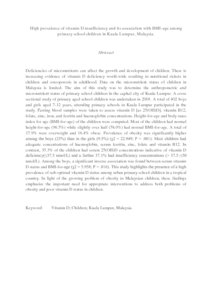Citation
Khor, Geok Lin and Chee, Winnie Siew Swee and Mohd Shariff, Zalilah and Poh, Bee Koon and Arumugam, Mohan and Ab Rahman, Jamalludin and Theobald, Hannah E.
(2011)
High prevalence of vitamin D insufficiency and its association with BMI-age among primary school children in Kuala Lumpur, Malaysia.
BMC Public Health, 11.
art. no. 95.
pp. 1-8.
ISSN 1471-2458
Abstract
Deficiencies of micronutrients can affect the growth and development of children. There is increasing evidence of vitamin D deficiency world-wide resulting in nutritional rickets in children and osteoporosis in adulthood. Data on the micronutrient status of children in Malaysia is limited. The aim of this study was to determine the anthropometric and micronutrient status of primary school children in the capital city of Kuala Lumpur. A cross sectional study of primary aged school children was undertaken in 2008. A total of 402 boys and girls aged 7-12 years, attending primary schools in Kuala Lumpur participated in the study. Fasting blood samples were taken to assess vitamin D [as 25(OH)D], vitamin B12, folate, zinc, iron, and ferritin and haemoglobin concentrations. Height-for-age and body mass index for age (BMI-for-age) of the children were computed. Most of the children had normal height-for-age (96.5%) while slightly over half (58.0%) had normal BMI-for-age. A total of 17.9% were overweight and 16.4% obese. Prevalence of obesity was significantly higher among the boys (25%) than in the girls (9.5%) (χ2 = 22.949; P < .001). Most children had adequate concentrations of haemoglobin, serum ferritin, zinc, folate and vitamin B12. In contrast, 35.3% of the children had serum 25(OH)D concentrations indicative of vitamin D deficiency(≤37.5 nmol/L) and a further 37.1% had insufficiency concentrations (> 37.5-≤50 nmol/L). Among the boys, a significant inverse association was found between serum vitamin D status and BMI-for-age (χ2 = 5.958; P = .016).
This study highlights the presence of a high prevalence of sub-optimal vitamin D status among urban primary school children in a tropical country. In light of the growing problem of obesity in Malaysian children, these findings emphasize the important need for appropriate interventions to address both problems of obesity and poor vitamin D status in children.
Download File
![[img]](http://psasir.upm.edu.my/24664/1.hassmallThumbnailVersion/High%20prevalence%20of%20vitamin%20D%20insufficiency%20and%20its%20association%20with%20BMI.pdf)  Preview |
|
PDF (Abstract)
High prevalence of vitamin D insufficiency and its association with BMI.pdf
Download (188kB)
| Preview
|
|
Additional Metadata
Actions (login required)
 |
View Item |

